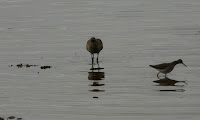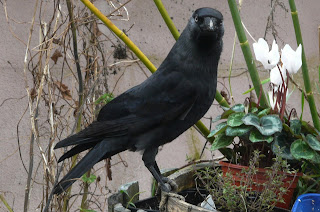Most of us can still remember we have to walk(to school) on the right side of the road, and should be facing the oncoming traffic. In countries where they drive on the left, of course- in others like on the European continent, it is simply the other way around.
In fact, I'd trouble every time I returned from a holiday in the UK, and I was crossing the road. I would automatically look to the right first, and this has created some near misses more than a couple of times.
Once I decided on doing a post on road safety for wheelie birders, I asked both the RSA or road safety authority in Ireland(RSA) and the Irish Wheelchair Association (IWA) on to which side of the road we should stick to when going for a spot of birding or (other) wildlife watching.
This is the reply from the RSA
and that of the IWA was very much similar. I would like to add though that on narrow or on busy roads, I switch to the left whenever I am approaching a bend in the road.
Not that I am criss-crossing constantly, but I find it very dangerous to stay on the right when there is a bend to the right coming up. The oncoming cars have no idea that I am there, yet if I change to the left hand side, they can see me from the (right) side
and drivers on the left side, coming up behind me, can see me also.
It is not only bends which makes me change sides though:
these do too,



The (Cork)county council fails to see that the edge of the road on the right side is about 80 cm further to the right than that it is, as used by vehicles on this road at the moment.
And if I as a wheelie go over this road and keep as much to the side as is possible, I am also 80cmto the left of there where you can see a bit of even-ness on the road, almost 1.5 metres from the grass!
When I was in Bantry, I thought it best to keep to the pavement along the N71, the main Cork-Kenmare/Glengarriff road when I was looking for a bit of autumn colour. However, the problem with these pavements is always- you might be able to get up onto one, but will you be able to get off it as well?? And with the pavement running out of town, I had absolutely no idea, and this kept milling in the head while I was going down.
I was on my way to the Abbey. At the other side of the road, a kind of large pond was created which is tidal and gives the idea of a nice lake there where the Bantry boat club has its clubhouse.

Here you get a glimpse of the cemetery which looks out onto the bay, and being on a slope, the view must be excellent! Lovely birding from there too in your days of peace.

a new life waiting for the wind.

A friend had suggested the gardens of Bantry House as an alternative for miss Lumix (my camera) but I wanted to show her that access is hopeless along all the gravel paths.
I might not get into the gardens, I was taken by this lovely 'Hobbit tree'

Bantry House is on the slope here, where it still has a very large gun outside, facing the bay.

These are across from the road, from the Abbey, a picture of The Sugar Loaf Mountain near Glengarriff, and a house on the island.


Here you can see the Sugar Loaf Mountain and the Hungry Hill Mountain which stands at the end of the Beara Peninsula, which lines the Bantry Bay on the north side.


The council has started making a walkway along Bantry Bay, 'just' around the town so to speak from the old pier to New Town. Although they had started building this, work has stopped because of disagreement over ownership of the land. In short, this can take a long time to be finished.
It would be a safe way to go birding, although I have no idea how easy the access will be at the other end. I still have to enquire if it is accessible anyway.
I had planned to go and take a look, that afternoon, after returning from the Abbey. However, with fingers like icicles, I needed a glove first. So after finishing my drink in the hotel, I went to the shop first. I told the girl there, colour is no issue, but I need to be able to operate the camera. So for € 7.-- I got a pair, of which the left-hand one is up at Rehab, seeking a left- handed one hander.
It was by then already past four and as you can see in my last picture, the evening was setting fast.
And the next day I totally forgot. Only when seeing this photo upon my return home did I spot the walkway which I had failed to investigate.



























































